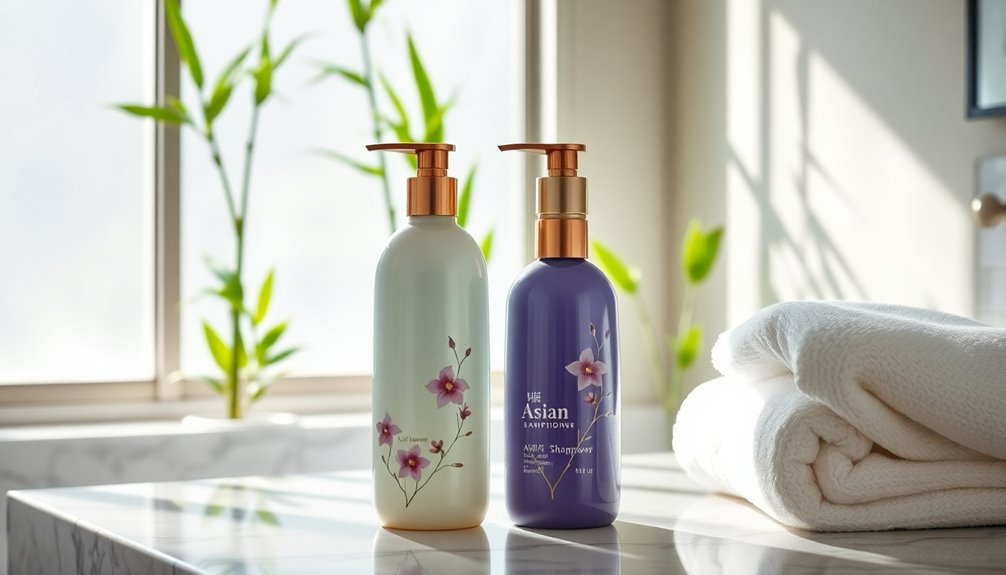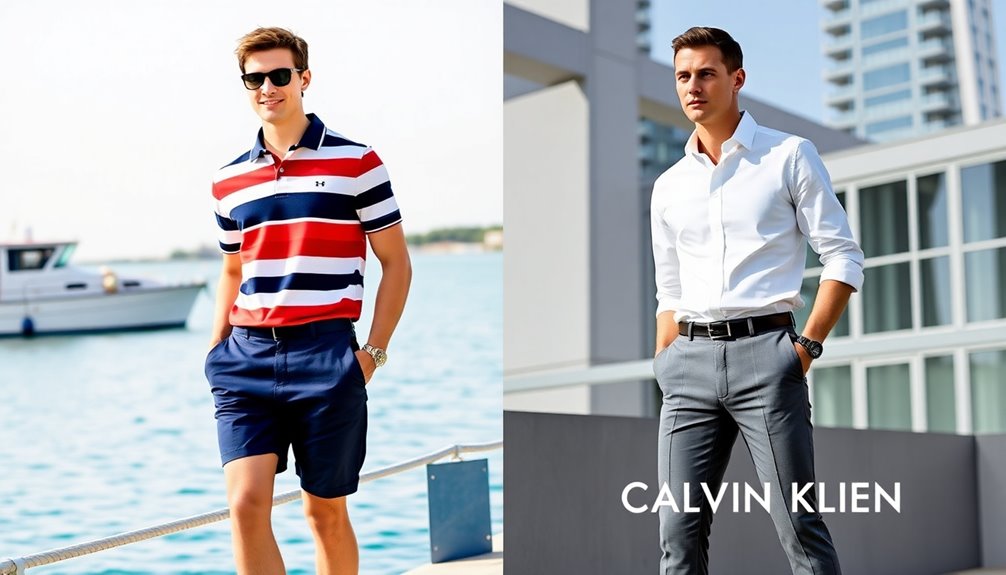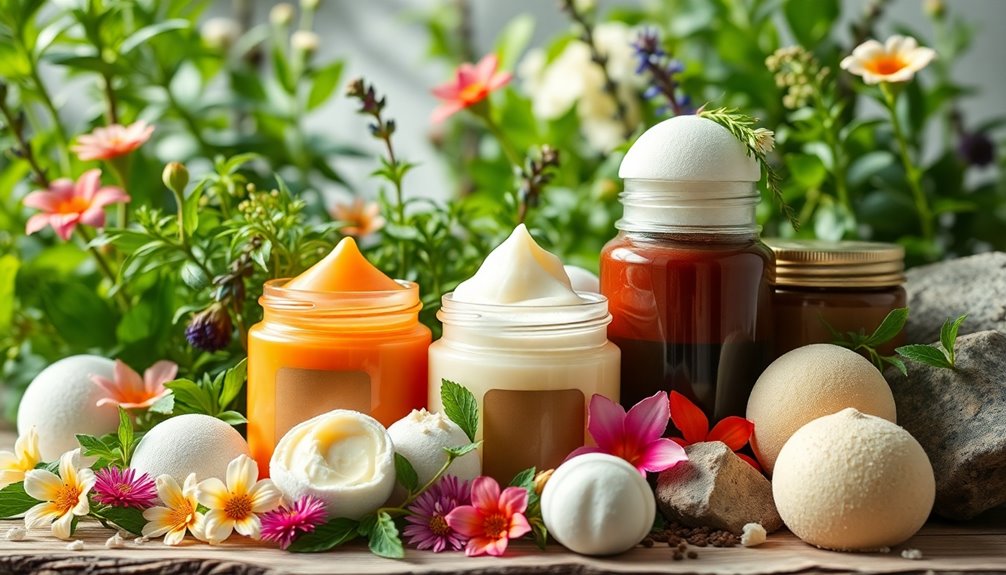Asian shampoos and conditioners feature potent ingredients like rice water, ginseng, and coconut oil that work wonders for your hair. These products cater to Asian hair's unique texture and needs, promoting strength, moisture, and shine. You'll love how these formulations prevent damage and enhance growth while maintaining scalp health. By using sulfate-free options and proper techniques, you can maximize the benefits and achieve salon-worthy results at home. Plus, incorporating natural elements can give your hair that glossy finish you crave. Want to unlock more details about these secrets for beautiful hair?
Key Takeaways
- Asian shampoos often feature rice water and ginseng, which strengthen hair and promote thickness through essential vitamins and minerals.
- Lightweight oils, like camellia and coconut oil, provide nourishment without weighing hair down, enhancing shine and moisture retention.
- Regular scalp care, including gentle exfoliation and hydration, supports a healthy environment for hair growth and reduces product buildup.
- Utilizing sulfate-free formulations ensures gentle cleansing, making them ideal for colored or sensitive scalps while maintaining hair integrity.
- Ingredients like hyaluronic acid and CBD offer revitalization and soothing properties, promoting overall hair health and growth.
Key Ingredients for Asian Hair

When it comes to caring for Asian hair, understanding the key ingredients can make a significant difference in achieving healthy, vibrant locks.
You'll want to incorporate traditional and natural ingredients like rice water, which strengthens and smooths your hair thanks to its rich vitamins and minerals. Ginseng stimulates your scalp, promoting thicker, healthier hair, while camellia oil offers lightweight nourishment and a glossy sheen without weighing you down.
Also, consider green tea for its antioxidants that protect against environmental damage. If you're looking for growth support, forbidden black rice fights hair loss and promotes scalp health. Ingredients like saw palmetto reduce shedding, while biotin boosts keratin production for stronger strands. Additionally, a popular choice for moisturizing is ceramide, which smooths out damaged hair, or aloe vera, known for its hydrating properties.
Lastly, hyaluronic acid revitalizes dry hair, giving it a sleek finish. By focusing on these key ingredients, you'll not only enhance the health of your hair but also achieve the vibrant look you desire.
Embrace these potent elements to transform your hair care routine!
Understanding Hair Texture and Needs
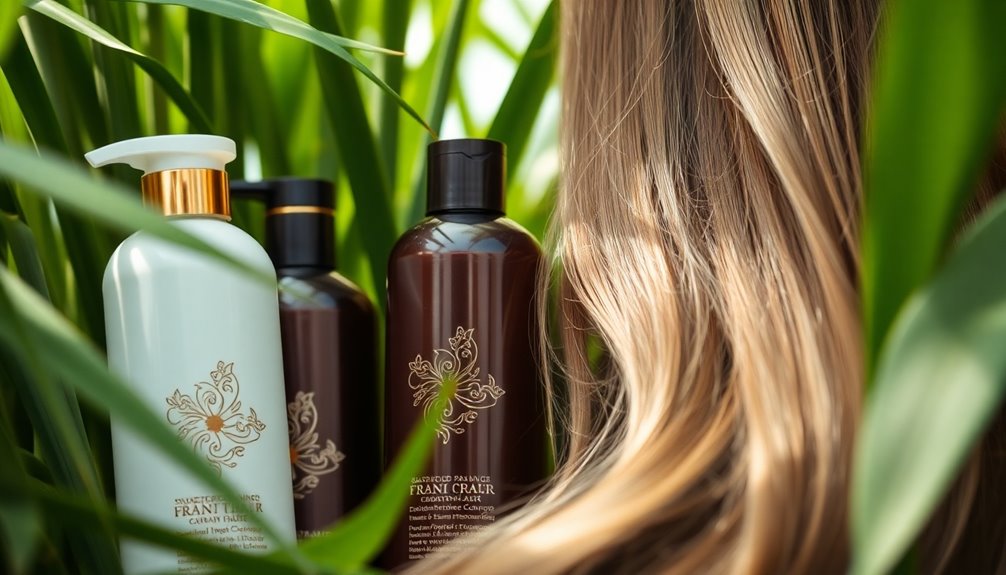
Understanding your hair texture and needs is crucial for effective hair care, especially when it comes to Asian hair. Typically, Asian hair is straight with a round cylindrical shape, giving it a thicker diameter than other hair types. This unique structure means your hair has about 10 layers of cuticles, making it more resilient and resistant to breakage.
However, while Asian hair has a high tensile strength, it can be more susceptible to chemical damage due to the adhesive proteins that hold the cuticles together. You might notice that your hair grows faster, around 1.4 cm per month, and has a longer growth cycle, lasting up to nine years. Additionally, the thicker cuticles present in Asian hair lead to increased resistance against damage, making it important to choose products that complement this feature.
Despite having fewer hairs per square centimeter, your hair sheds less and experiences less balding. Understanding these characteristics helps you choose the right products and care techniques.
For instance, knowing that your hair has higher porosity means you can benefit from moisture-rich shampoos and conditioners. By recognizing your hair's unique texture and needs, you can maintain its health and enhance its natural beauty effectively.
Effective Shampoo Formulations
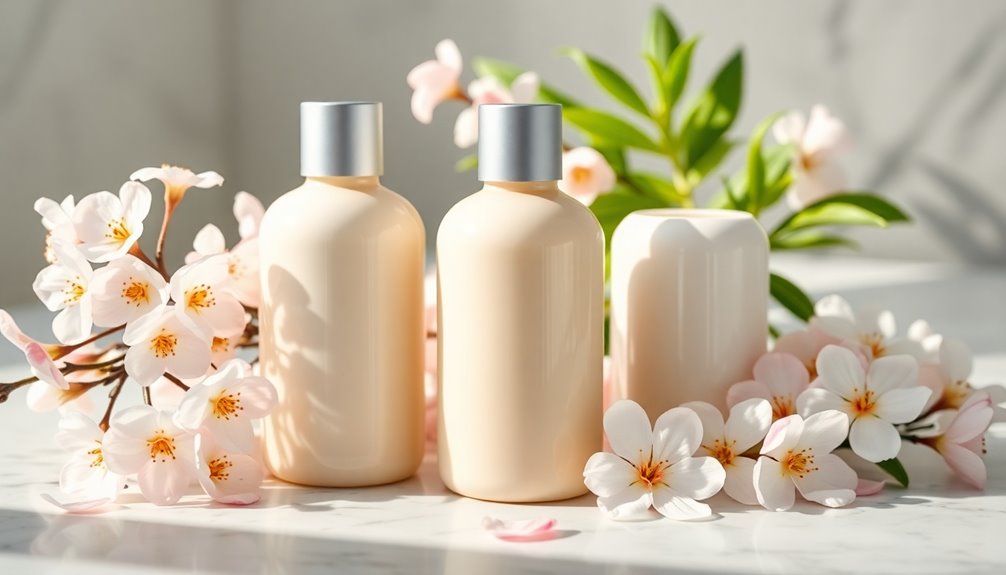
Effective shampoo formulations for Asian hair harness traditional ingredients and modern innovations to cater to its unique characteristics.
You'll find that many effective shampoos incorporate coconut oil, which helps retain moisture and prevent damage thanks to its fatty acids. Fermented rice water, rich in vitamins and amino acids, is another staple that promotes shiny, strong hair. Local herbs like fleece flower root and fresh ginger enhance these formulations, providing additional benefits. Additionally, many shampoos are specifically designed to address common hair issues such as oiliness and frizz, ensuring a tailored approach to hair care.
Natural ingredients like aloe vera and camellia oil are also common. Aloe vera hydrates without greasiness, while camellia oil maintains moisture. If you have colored hair or a sensitive scalp, sulfate-free options with oat grass and wheat germ extracts cleanse gently without stripping essential oils.
Modern innovations, such as bio-fermented coconut water and hyaluronic acid, help plump and revitalize dry, damaged hair.
You'll also notice shampoos featuring CBD for anti-inflammatory benefits, soothing your scalp and boosting circulation.
With such a blend of traditional wisdom and contemporary science, you're sure to find a shampoo that meets the specific needs of your hair, leaving it healthy and beautiful.
Proper Conditioner Usage Techniques
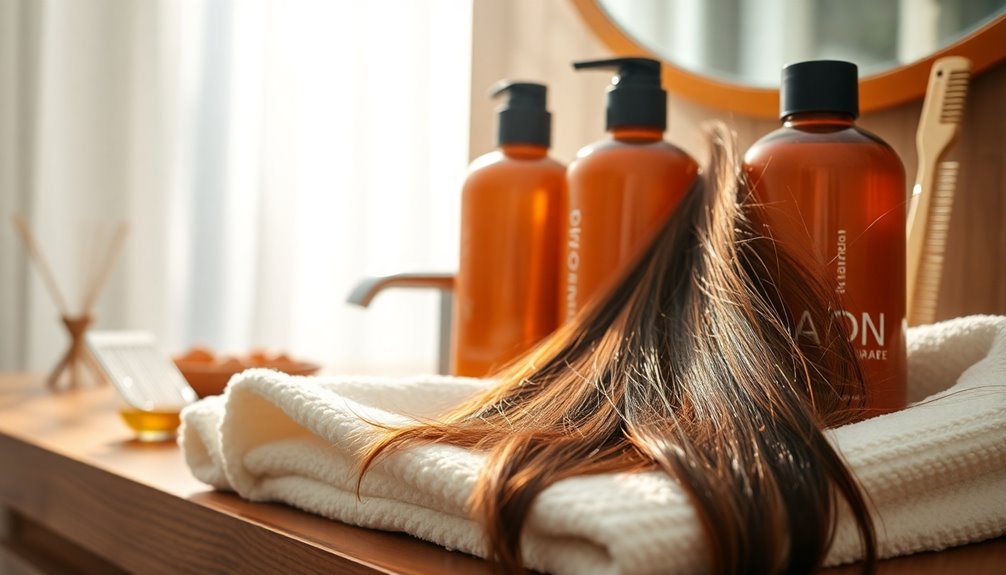
After you've chosen the right shampoo for your Asian hair, the next step is ensuring you apply conditioner effectively to maximize its benefits.
Start by rinsing your hair thoroughly to remove all shampoo residue. Squeeze out excess water; your hair should be damp, not soaking wet, for the best absorption.
Use a coin-sized amount of conditioner, adjusting based on your hair type and length. Apply it from the mid-lengths to the tips, avoiding the scalp. Focus on the older, damaged sections to give them extra care.
Use your fingertips or a wide-toothed comb to distribute the conditioner evenly. If your hair is thick or long, section it off to ensure thorough coverage.
Gently massage the conditioner into your hair to coat each strand, then detangle with a wide-toothed comb. Allow the conditioner to absorb for 1-3 minutes, or longer for deep treatments. This step is crucial as it helps to strengthen hair cuticles, preventing breakage and promoting healthier hair.
Finally, rinse it out thoroughly with cooler water to lock in moisture, ensuring no slippery texture remains. Afterward, gently dab your hair dry to prevent damage, and consider a leave-in treatment for added nourishment.
Importance of Scalp Health
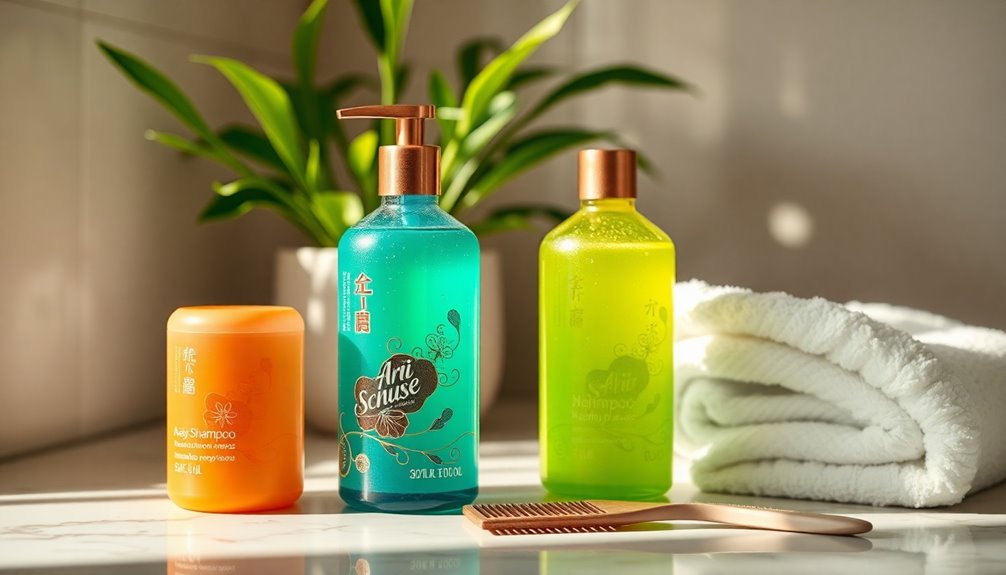
Maintaining a healthy scalp is essential for vibrant hair and overall wellness. Regular cleansing helps remove excess oil, dirt, and product residue, creating a balanced scalp environment. By using a gentle, sulfate-free shampoo, you preserve your scalp's natural oils, preventing dryness and irritation. If you notice buildup, use clarifying shampoos sparingly to avoid over-drying your scalp.
Your diet plays a significant role in scalp health, too. Eating a balanced diet rich in vitamins A, C, and E, omega-3 fatty acids, and zinc supports optimal scalp condition. Don't forget to drink plenty of water; proper hydration keeps your scalp and hair nourished from within. A healthy scalp supports shinier, stronger, voluminous hair.
Environmental factors like UV rays and pollution can disrupt your scalp's health, leading to irritation and dryness. Protect your scalp from these external aggressors by wearing hats or using sunscreen.
Additionally, regular scalp care practices, such as gentle exfoliation and massage, can boost blood circulation and enhance hair growth.
Washing Techniques for Best Results
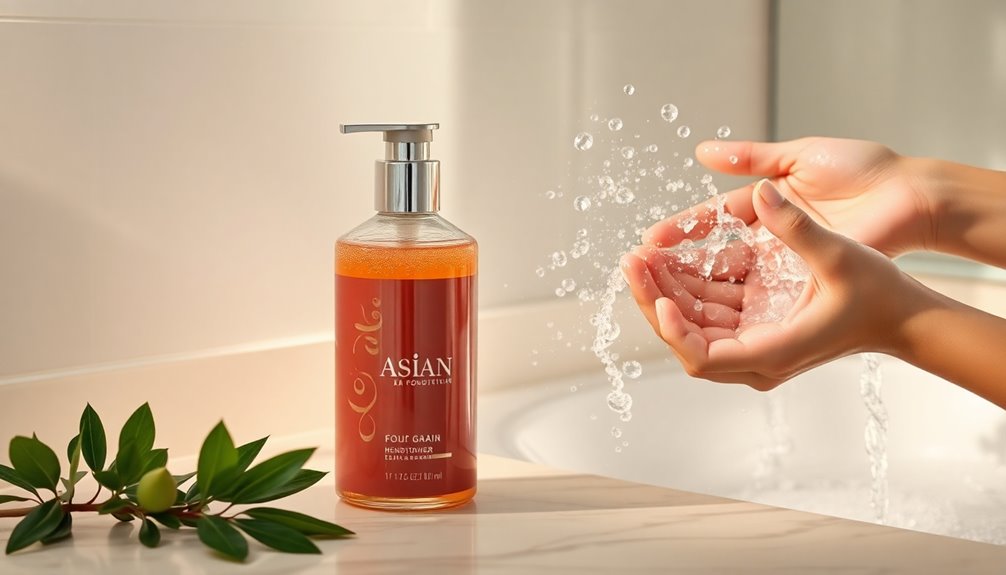
To achieve the best results when washing your hair, it's crucial to adopt proper techniques from start to finish.
Start by brushing your hair thoroughly with a large paddle brush before wetting it. This helps remove tangles and reduces breakage.
Wet your hair with warm water—avoid extremely hot temperatures to prevent damage.
Apply shampoo directly to your scalp, massaging it in to effectively remove dirt and sweat. Rinse thoroughly, ensuring all lather is washed away before repeating the shampooing process to cleanse the hair itself.
When it's time to condition, focus on applying conditioner to the middle and ends of your hair, steering clear of the scalp. Additionally, consider using a wide-toothed shower comb for gentle detangling while distributing the conditioner evenly.
Use a wide-toothed or detangling comb to distribute the conditioner evenly and detangle. Allow the conditioner to sit for 2-3 minutes for maximum absorption, then rinse with cooler water to close the hair cuticle.
As you condition, wind your hair into a bun and secure it with a claw clip.
After rinsing, dab your hair dry with a hooded towel, avoiding any rubbing to reduce friction and damage.
Follow these steps for healthier, more beautiful hair.
Tips for Maintaining Hair Health
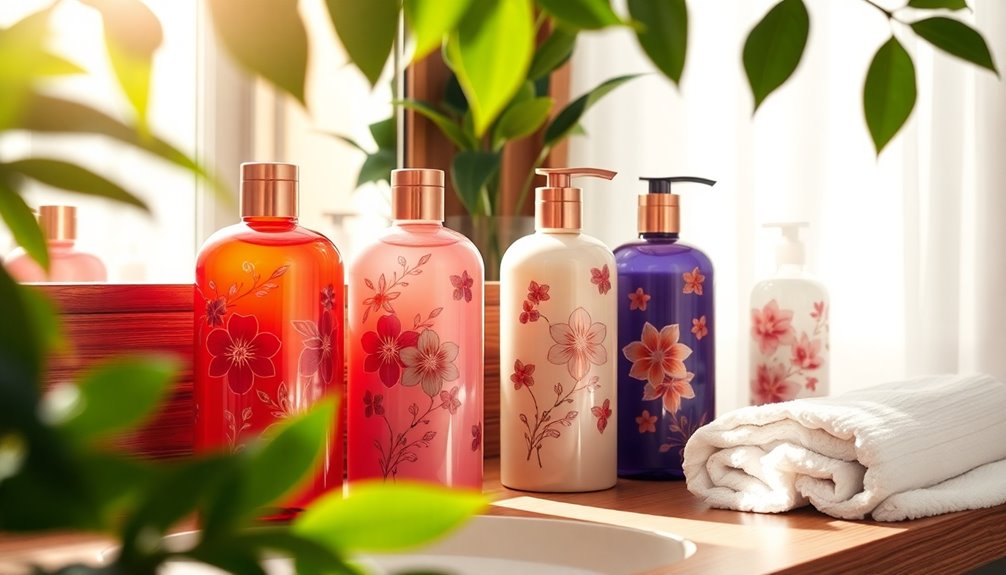
Achieving and maintaining healthy hair requires attention to both the products you use and your overall hair care routine. Start by choosing shampoos and conditioners with ingredients that support your hair type. Look for hyaluronic acid for hydration, aloe and coconut juice for lightweight moisture, and anti-inflammatory ingredients like CBD to promote growth and soothe your scalp.
Maintaining scalp health is crucial. Use products with a pH level between 4.5 and 5.5 to match your scalp's natural balance and avoid harsh additives like sulfates and parabens. Regularly incorporate shampoos with green tea and herbal extracts to protect and calm your scalp. Additionally, consider using sulfate-free formulas that are gentle on hair and scalp, which can help maintain moisture balance.
To prevent damage and breakage, use conditioners that smooth the hair cuticle and consider rice water as a natural conditioner. It can help prevent fraying and promote longer hair.
For promoting growth, select shampoos containing camellia oil, ginger, and amla. These ingredients not only nourish your hair but also increase circulation, which is essential for reducing hair loss.
Frequently Asked Questions
How Often Should I Wash My Hair for Optimal Health?
To keep your hair healthy, washing frequency depends on your hair type and scalp condition.
If you have oily hair, wash daily to prevent buildup. For dry or damaged hair, aim for every 5-7 days.
Fine hair benefits from washing every other day, while wavy or curly hair does well with every 4-5 days.
If you're active or exposed to dirt, adjust as needed.
Always listen to your hair and scalp for the best results.
Can I Mix Different Brands of Shampoo and Conditioner?
You can mix different brands of shampoo and conditioner, but it mightn't always be the best choice.
Each brand formulates its products to work together, ensuring balanced benefits. Mixing brands can lead to ingredient clashes, possibly stripping your hair's natural oils or causing adverse reactions.
If you have specific hair needs, consider choosing products based on those rather than brand loyalty. Tailoring your routine can often yield better results for your unique hair type.
What Are the Benefits of Using a Hair Mask?
Using a hair mask offers numerous benefits for your locks.
It deeply hydrates and nourishes, especially if your hair feels dry or damaged. You'll notice improved strength, reduced breakage, and enhanced shine.
A good mask can also help with detangling, making your hair easier to manage. Plus, it promotes a healthier scalp, which supports hair growth.
Regular use can lead to softer, more vibrant hair that looks and feels revitalized.
How Can I Tell if My Hair Is Damaged?
You can tell if your hair is damaged by checking for signs like dullness, dryness, and rough texture.
If your hair feels brittle or breaks easily, that's a clear indicator.
Look for split ends and increased tangling, making it hard to style.
Notice any lack of elasticity, where your hair doesn't bounce back when stretched.
If you see frizz or fading color, these are all signals that your hair needs some care.
Are There Any Specific Ingredients to Avoid in Hair Products?
When choosing hair products, you should avoid certain harmful ingredients. Steer clear of sulfates like SLS and SLES, as they can strip your hair of natural oils.
Parabens are another no-go, since they mimic estrogen and may pose health risks. Additionally, watch out for formaldehyde releasers and synthetic fragrances, which can irritate your scalp.
Instead, opt for sulfate-free and paraben-free formulas that are gentler on your hair and overall health.
Conclusion
Incorporating Asian shampoo and conditioner into your hair care routine can truly transform your locks. By understanding your hair's unique texture and needs, and using effective formulations, you'll achieve healthier, more beautiful hair. Don't forget the importance of scalp health and the right washing techniques to maximize results. With these tips in mind, you're well on your way to maintaining vibrant, lustrous hair that turns heads. Embrace the journey to fabulous hair—you deserve it!
